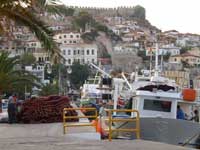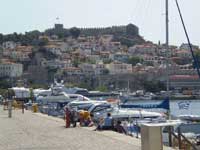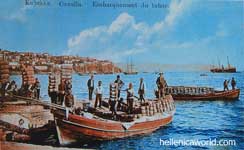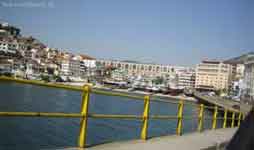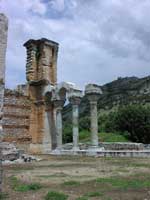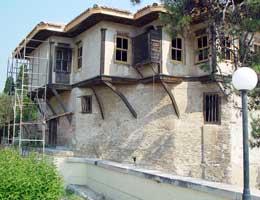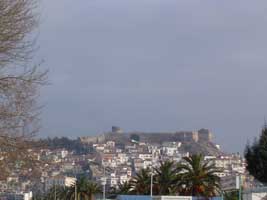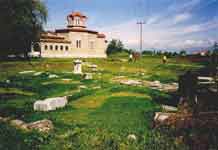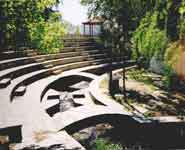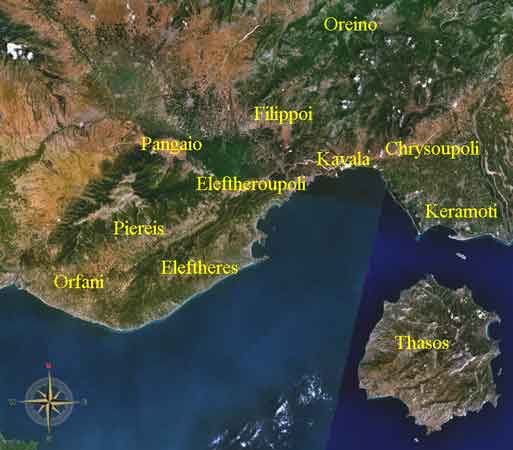.
Administrative Region : East Macedonia and Thrace
Regional unit : Kavala
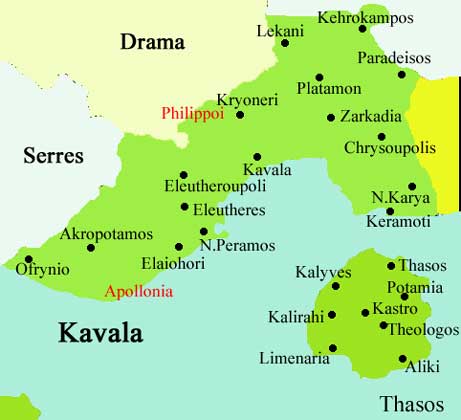
Kavala (Greek: Καβάλα), is the second largest city in northern Greece, the principal seaport of eastern Macedonia and the capital of Kavala peripheral unit. It is situated on the Bay of Kavala, across from the island of Thasos. Kavala is located on the Egnatia motorway and is a two-hour drive to Thessaloniki (160 km west) and forty minutes drive to Drama (37 km north) and Xanthi (56 km east). As you enter Kavala, you will admire the panoramic view of the town that is nestled between the slopes of the surrounding hills and the northern coast of the Aegean Sea.
History
Antiquity
The city was founded by settlers from Thassos in about the 6th century BC, who called it Neapolis (Νεάπολις; "new city" in Greek).

Medusa coin from Neapolis (Greek Wikipedia)
Neapolis was a town of Macedonia, and the harbor of Philippi, from which it was distant 14 km. It probably was the same place as Datum (Δάτον), famous for its gold mines (Herod. ix. 75; comp. Böckh, Pub. Econ. of Athens, pp. 8, 228, trans.), and a seaport, as Strabo (vii. p. 331) intimates: whence the proverb which celebrates Datum for its good things. (Zenob. Prov. Graec. Cent. iii. 71; Harpocrat. s. v. Δάτος.)
1480 : Fragment of a stele with a decree. Hymettan marble.
Scylax does, indeed, distinguish between Neapolis and Datum; but, as he adds that the latter was an Athenian colony, which could not have been true of his original Datum, his text is, perhaps, corrupt in this place, as in so many others, and his real meaning may have been that Neapolis was a colony which the Athenians had established at Datum.
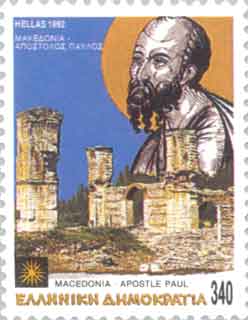
Apostle Paul in Kavala
Zenobius (l. c.) and Eustathius (ad Dionys. Perieg. 517) both assert that Datum was a colony of Thasos; which is highly probable, as the Thasians had several colonies on this coast. If Neapolis was a settlement of Athens, its foundation was, it may be inferred, later than that of Amphipolis.
Neapolis was a member of the Athenian League, as a pillar found in Athens mentions a contribution of Neapolis to the alliance. Neapolis also minted coins in antiquity.

Kavala, view from Stavros Agios Silas
Roman Era
The Kavala aqueduct.
It became a Roman civitas in 168 BC, and was a base for Brutus and Cassius in 42 BC, before their defeat in the Battle of Philippi. (Appian, B.C. iv. 106; Dion Cass. xlvii. 35.). The Apostle Paul landed at Kavala on his first voyage to Europe (Acts, xvi. 11).
Byzantine Era
View of Kavala's castle.
In Byzantine times the city was called Christoupolis by the Greeks and Morunets (Морунец) by the Bulgarians. In the 6th century Byzantine emperor Justinian I fortified the city in an effort to protect it from barbaric raids. In the 8th and 9th century Bulgarian attacks forced the Byzantines to reorganize the defense of the area, giving great care to Christoupolis with fortification and a notable garrison. Due to the location of Christoupolis, the city experienced an economic flourish. During the Norman raid in Macedonia (1185), the city was captured and was burned.
Ottoman Era
The house of Muhammad Ali of Egypt.
Kavala was part of the Ottoman Empire from 1387 to 1912. In the middle of the 16th century, Ibrahim Pasha, Grand Vizier of Suleiman the Magnificent, contributed to the prosperity and growth of Kavala by the construction of an aqueduct.[1] The Ottomans also extended the Byzantine fortress on the hill of Panagia. Both landmarks are among the most recognizable symbols of the city today.

City of Kavala [Source]
Mehmet Ali, the founder of a dynasty that ruled Egypt, was born in Kavala in 1769. His house has been preserved as a museum.
Modern Kavala
Kavala c.1900.
The old town (Panagia)
View of the port and downtown.
Kavala was captured by the Bulgarians in First Balkan War in 1912 and Greek Navy during the Second Balkan war in 1913. After the Greco-Turkish War of 1919, the city entered a new era of prosperity because of the labour offered by the thousands of refugees that moved to the area from Asia Minor. The development was both industrial and agricultural. Kavala became greatly involved in the processing and trading of tobacco. Many buildings related to the storage and processing of tobacco from that era are preserved in the city.

Liberation of Kavala, Vasileios Hatzis
It was occupied again by Bulgaria between 1941–1944 during World War II.
In the late 50s Kavala expanded towards the sea by reclaiming land from the area west of the port.
In 1967, King Constantine II left Athens for Kavala in an unsuccessful attempt to launch a counter-coup against the military junta.
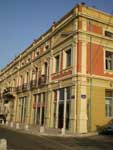
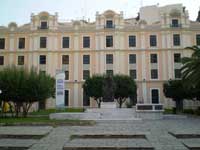
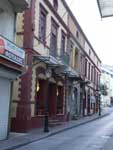
Kavala, Photos: Eleni Aristeidou
Sightseeing
Monuments and landmarks
The imaret
The town hall
Megali Leschi
Municipal Tobacco Warehouse
Kamares (The old Aqueduct): The Old Aqueduct, the Medieval Aqueduct, is work of the Byzantine period, which held extensive repairs during the Ottoman rule, particularly during the reign of Suleiman the Magnificent and Legislator (1530 AD approx.) This double arch structure was designed to bridge the peninsula of Panagia with the foot of the mountain of Lekani. It was used to carry water from mountain sources (six kilometers north from the 'Mother of Water "or" Soumpasi "or" The Three Elms") in today's" Old Town "- Panagia, with the main water source situated at an altitude of 400 m and other complementary lower sources of supply. This grand monument has a length of 280 m consists of 60 arches of four different sizes and has a maximum height of 25 meters. The restoration works began in September 1997 with a mild technical assistance.Source: «Medieval Aqueduct of Kavala – Arcs», Publication of 12th Service of Byzantine and Ancient Antiquities, Kavala, 2008
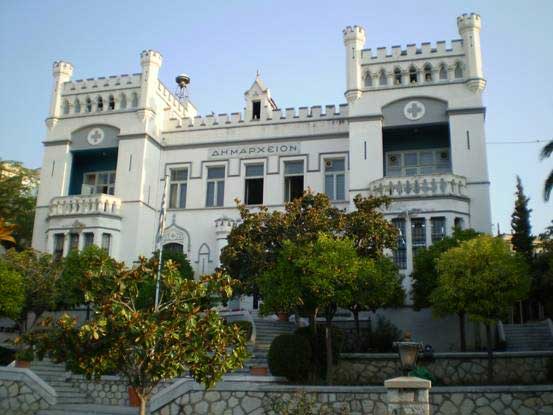
Kavala, Town Hall. Photo: Eleni Aristeidou
The Castle of Kavala [3]:dominates the top of the peninsula, where the old city is built. During the Byzantine period and later, repeated reconstruction works and fortification repairs were made by the Byzantines, Venetians and Turks. Substantially, all the phases of the Modern History affect the castle and left their traces on its walls. The castle (Citadel) in its current form was built in the first quarter of the 15th century, relying on foundation from the Byzantine period. At the outdoor theatre are organized cultural events
The Imaret:The Imaret, a big edifice of the late Ottoman period, a classic example of Islamic architecture located on the west side of the peninsula of Panagia (old town). It is one of the last built in this particular period and the only one survived almost intact. Its largest part was built, between 1817-1821 by the founder of the last Egyptian dynasty, Mehmet Ali. For sentimental reasons, the Wali of Egypt wanted to benefit his hometown with this religious, educational and charitable institution. It operated as a Muslim seminary - internship and "workhouse" for all the poor of the city regardless of religion.Since 1922, the Imaret spaces were used to house refugees. In 1931, in order for the adjacent street to be widened, a part of Imaret was demolished. In 1967 the residents (refugees mostly) of Imaret were ordered to leave and the monument was sealed.Until the regulation of the ownership, Imaret remained completely deserted. After the settlement of property issues a part of it operated as bar and restaurant while other parts were used as warehouses. In 2001 it was leased for 50 years to an entrepreneur from Kavala, it was restored and converted into a luxurious and elegant hotel, which maintains something of the ambience of its era.Source: «Neapolis - Christoupolis - Kavala, Travelogue through space and time of the Old City», Publication of Kavala’s Municipalityς, Kavala, 2009
|
|
|
The house of Mehmet Ali:In the Old Town Square you can find the house that Mehmet Ali, founder of the last Egyptian dynasty, was born. This beautiful building, based on Macedonian architecture, is considered to be the property of Egypt . The "konaki" of Mehmet Ali consists of two parts, the ground floor and first floor. A bronze equestrian statue was built in the centre of the square in 1934 in honour of the Sultan of Egypt, a work of Greek sculptor Dimitriadis. Nowadays, the building is used for the purposes of Mohammed Ali Institute[4]
The town hall :The building, a Hungarian miniature tower, was built around 1895 by the Hungarian tobacco trader Pierre Herzog. After his death, the building passed into the possession of the "Limited Liability Company of Tobacco and Overseas". In 1937, under the administration of Mayor Athanasios Balanos, it was purchased by the Municipality of Kavala and has since housed the town hall.
Adolf Wix Building:The building was built in 1899 by the German Baron Adolf Wix to serve as the centre of commercial activity and as a house. Architecturally speaking, it is very similar to the adjacent building of the current town hall. Today, after several changes in ownership, it belongs to the municipality of Kavala.
The Lazarists (Vincentians) Convent:The convent of Lazarists is situated in Kipros Str. and was built between 1888-1892. The building has architectural elements mixed with neoclassical influence and was used as a French Embassy. Today it houses the only Catholic church in the city.
The great Greek community club:The building of «Megali Leschi» of the Great Greek Community Club of Kavala was built in 1909 by the Ladies Philoptochos (Friends of the poor) Sisterhood. It is a typical example of eclectic architectural style with a lot of embedded neoclassical motifs, e.g. Columns, Pediments etc. Located next to the town hall, it is used for secular organization and other social events. While in neoclassical form it has elements of ancient tradition. Today, its partially used by the Municipality for cultural events due to the restoration works that have already started.
Tokos Mansion:Tokou Mansion was built in 1879 by Dimitrios Tokos a tobacco trader and its architectural style is influenced by romantic eclecticism. During the first years of the 20th century the Mansion was used as Italian Subconsulate and in 1911 it was purchased on behalf of the Ladies Philoptochos Society of Kavala (Friends of the Poor). From 1913 to1937, it housed the town hall and from its terrace in 1929 Eleftherios Venizelos made his speech. After the Second World War it housed the Private School Papassideri. Today it houses the Revenue Department of Byzantine Antiquities.
Municipal conservatory [5]:The building of the Municipal Conservatory (along with the adjacent building once owned by Kleon Krantonellis) is the oldest among the houses having been built before 1864.It belonged to the N. and E. Grigoriadis Brothers, two of the first tobacco traders. After the World War One it served as a Bank and since 1987 (it was inaugurated in its present form in 1990) it has belonged to the Municipality of Kavala and houses the Municipal Conservatory. Its strong neoclassical character, its impressive frontons, the columns and the sculptures indicate the architect's attempt to emphasize on the power, wealth and the national pride sourcing from the ancient tradition.
Municipal Tobacco Warehouse:The Municipal Tobacco Warehouse was built during the two first decades of the 20th century as a tobacco warehouse for the Turkish tobacco trader Kizi Mimin. The building is characterized by architectural and morphological elements of Ottoman-Turkish and Neo-Classical architecture.Today it belongs to the Municipality of Kavala and will host exhibits of the Folk Museum of Kavala, the Tobacco Museum and series of temporary exhibitions.
Museums
Archaeological Museum of Kavala: The history of the Museum of Kavala, together with that of the Archaeological Service in the region, starts in 1934 with the allocation of the first curator of Antiquities G. Bakalakis in Kavala, who later became a professor at the Aristotle University of Thessaloniki. During the occupation of Kavala from the Germans and the Bulgarians, the museum was looted and many antiquities were smuggled or destroyed. In recent years the museum takes its most complete form. Built next to Faliro park and in the left side of the port. Among the finds that it accommodates are objects made of stone and clay from the Neolithic period and the Bronze Age, as well as all the findings of the Dikili Tas settlement. There is also a special room with the findings of Neapolis, such as remnants of the temple of Athena Parthenos (Athina the Virgin), archaic and classical black-figure vases and figurines. The findings from Ancient Amphipolis are also very important.
Archaeological Museum of Philippi
Folklore Museum of Kavala: The Municipal Museum of Kavala first opened in 1988 and was housed for about 20 years in a neoclassical building on Filippou street. Recently, its exhibits have been transferred to the building of the Municipal Tobacco Warehouse of Kavala, at Kapnergatis Square, where for the time being only its administrative services are in operation. However, soon the works will have finished and the Museum will start operating again fully at these new premises. The museum is separated under the following departments. (Historical Archives, Ethnographic Collection, Art Collection, Natural History, Library, Museum education)
The Tobacco museum of Kavala
Tobacco Museum [6]:The tobacco museum of Kavala is a thematic museum, which includes objects and archival material for the cultivation and the production of tobacco, its commercial and agricultural processing, its industrial tobacco products and exhibition samples. It not only includes and exhibits the commercial processing of the Eastern Tobacco (not found in any other museum in the world) but it also showcases the social history of Kavala and the rest of the Eastern Macedonia and Thrace. Its collection is extremely rich. It includes objects used in the cultivation of tobacco, machinery, photographs, rare documents (bank documents, association statutes, etc.). The visitor can also find books on tobacco, publications of the Greek Organisation of Tobacco, archives of the Commercial Tobacco Association, private documents, tobacco maps and drawings, furniture etc.
Cultural House of Nea Karvali [7]:Nea Karvali of Kavala is a continuation of the old Kapadokian Karvali (Gelveri) with a long history through the ages. Its glorious course was marked by the presence of Her Holy Child, Gregory the Theologian, one the greatest Fathers of our Church. Since 1981, apart from the agricultural and industrial development, this course was affected by the foundation of the Cultural House of Nea Karvali, which is a continuation of the first educational organisation “Nazianzinos” founded in Istanbul by traders from Kavala in 1884. The Cultural House had a major contribution throughout its 70 year course, through its projects and institutions.
Maritime Museum of Kavala [8]:
Beaches
Kalamitsa beach
Rapsani Beach
Perigialli Beach
Toska Beach:Tosca beach is 5 km from Kavala. It has been awarded with the “blue flag” for its clear water and its organisation. It can be reached by taking the coach to Nea Peramos (for more information please call 2510-223593). There is an entrance fee to use the facilities. On the site there is a 4 star hotel, a restaurant and a cafeteria.
Batis Beach:A bay 4 km from Kavala. Organised beach awarded with the “blue flag”. There is also an organised campsite with 100 designated spots for camping. There is an entrance fee to use the facilities. The visitors will find water sports, swimming pools, a pool bar, a beach bar and a playground. During the summer months it can be reached by bus No. 8 as well as by taking the coach to Nea Peramos
Kalamitsa Beach:Organised beach of the municipality of Kavala on the west entrance of the city, awarded with the “blue flag” and accommodating a large number of bathers during the summer months. There is no entrance fee. Accessible by buses No. 4, No. 5 and No. 8. On the beach and nearby there are taverns and bars
Periyiali Beach:On the eastern entrance of the city, 2 kilometres from the city centre. A municipal beach, partly organised and awarded with the “blue flag” every year since 2009. Buses to and from Perigiali are No. 2 and No.3. In various parts of the beach there are fish taverns.
Rapsani Beach:For those who can’t leave the city, Rapsani is practically at the centre of it. A municipal beach, organised and awarded with the “blue flag” every year since 2009. There is no admission fee and it can be reached by buses No. 1, No. 4, No. 5, No. 8 and No. 10. A tavern and cafeterias are available.
Climate
Kavala has a humid subtropical climate (Köppen climate classification "Cfa") that borders on an semi-arid climate (Köppen climate classification "BSk" or "BSh" depending on the system used) with annual average precipitation of 460 mm. Snowfalls are sporadic, but happen more or less every year.
The absolute maximum temperature ever recorded was 38.0°C, while the absolute minimum ever recorded was −5.8°C.[2]
| Climate data for Kavala | |||||||||||||
|---|---|---|---|---|---|---|---|---|---|---|---|---|---|
| Month | Jan | Feb | Mar | Apr | May | Jun | Jul | Aug | Sep | Oct | Nov | Dec | Year |
| Average high °C (°F) | 9.9 (49.8) |
10.5 (50.9) |
12.8 (55.0) |
16.8 (62.2) |
21.1 (70.0) |
26.8 (80.2) |
29.7 (85.5) |
29.5 (85.1) |
25.9 (78.6) |
20.9 (69.6) |
14.6 (58.3) |
11.0 (51.8) |
19.6 |
| Daily mean °C (°F) | 6.8 (44.2) |
7.2 (45.0) |
9.3 (48.7) |
13.4 (56.1) |
17.7 (63.9) |
23.0 (73.4) |
26.5 (79.7) |
26.3 (79.3) |
22.4 (72.3) |
17.2 (63.0) |
11.4 (52.5) |
8.0 (46.4) |
15.8 |
| Average low °C (°F) | 3.0 (37.4) |
3.5 (38.3) |
5.4 (41.7) |
8.7 (47.7) |
12.6 (54.7) |
17.0 (62.6) |
20.3 (68.5) |
20.4 (68.7) |
16.4 (61.5) |
11.4 (52.5) |
6.7 (44.1) |
4.2 (39.6) |
10.8 |
| Precipitation mm (inches) | 17.9 (0.705) |
28.6 (1.126) |
37.9 (1.492) |
57.1 (2.248) |
32.8 (1.291) |
27.0 (1.063) |
28.0 (1.102) |
17.5 (0.689) |
10.4 (0.409) |
25.9 (1.02) |
67.4 (2.654) |
52.7 (2.075) |
403.2 (15.874) |
| % humidity | 64.9 | 65.0 | 66.6 | 65.8 | 67.8 | 67.8 | 68.4 | 68.8 | 67.7 | 65.8 | 66.1 | 67.7 | 66.9 |
| Avg. precipitation days | 5.9 | 7.0 | 8.5 | 10.5 | 9.3 | 8.5 | 5.5 | 4.8 | 4.3 | 7.3 | 10.2 | 9.3 | 91.1 |
| Source: Greek National Weather Service [9] | |||||||||||||
Education/Research
The Technological Educational Institute (panoramic view)
TEI of Kavala: The Technological Educational Institute of Kavala (Greek: ΤΕΙ Καβάλας) is a public institute providing education at university level in the region of Eastern Macedonia and Thrace. The main campus of the institute located in St. Lukas, Kavala and is approximately 132,000 m2 with buildings covering an area of 36,000 m2.The campus is home for 2 faculties (Faculty of Engineering Sciences and Faculty of Business and Economics) with totally 9 departments.
Fisheries Research Institute[10]: Fisheries Research Institute (F.R.I) is one of the five specialized research institutes of N.AG.RE.F, being responsible to conduct research and to promote technological development in the fishery sector. The Institute is located 17 km away from Kavala city, at the centre of a marine area with rich fishery grounds and high biodiversity in the surrounding lagoons, lakes and rivers.
Institute of Mohamed Ali for the Research of the Eastern Tradition (I.M.A.R.E.T.)[11]: I.M.A.R.E.T. is a registered NGO with the Hellenic Ministry of Foreign Affairs, which was established several months ago by concerned citizens in Kavala, Greece.Its aims include the study of the Egyptian influence in Greece and vice versa. The intra-cultural exchange and dialogue, as well as the promotion of art as a means of intra-cultural understanding.The first major co-operation partner is Cultnat of Bibliotheca Alaxandrina with the aim of documenting and digitizing the architectural heritage of the Mohamed Ali era in Egypt and Greece. Most important event that take place every year at the institute is the International Roman Law Moot Court Competition.
Historical & Literary Archives of Kavala[12]: It is purely a non-profiteering, public utility foundation. The foundation of the Historical & Literary Archives of Kavala is not subsidized by the Greek State, neither by any other enterprise of the private sector. Its operational cost is covered only by its founders and by infrequent aids of the local self-government.
Egnatia Aviation[13]: It is a private training college for pilots that started training in Greece in July 2006. The facilities of Egnatia Aviation mostly located in the former passenger’s terminal of the Kavala International Airport "Alexander the Great".
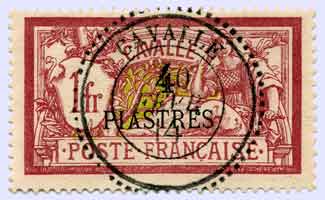
Between 1893 and 1903, the French post office in the city issued its own postage stamps; at first stamps of France overprinted with "Cavalle" and a value in piasters, then in 1902 the French designs inscribed "CAVALLE".
Culture
Festivals and events
Festival of Philippi
For visitors who seek food for their soul, as well as for their spirit, there is a wide array of cultural events, which mostly take place during the summer months. One of the top festivals is the Festival of Philippi[14], which lasts from July to September and includes theatrical performances and great concerts.Since 1957, it has been the most important cultural event of the city and one of the most important of Greece.
Cosmopolis. It is an International Festival held in the Old Town of Kavala and it constitutes an excellent opportunity for anyone to be acquainted with cultures around the world through dancing and musical groups, traditional national cuisines, cinema, and exhibits at the kiosks of the participant countries.
Giannis Papaioannou’s Festival includes concerts and music seminars.
Ilios ke Petra (Sun and Stone)(July)[15]: a Festival held in “Akontisma” of Nea Karvali. The event is of folkloric character, with the participation of traditional dancing groups from all over the world.
Wood Water Wild festival[16]: Wood Water Wild is an outdoor activities festival, inspired by nature. Add live bands & dj sets, body&mind activities, book fair, outdoor theatre, ecology, camping, debates and you have a recipe for a great weekend in nature!
Besides, various cultural events are held in all municipalities of Kavala during the summer months.
Cuisine
Fish and sea food, as well as the products of the local livestock breeding and agricultural sectors are the prevailing elements of Kavala courses. In Kavala, the traditional local recipes have been influenced by the cuisine of the refugees from Pontos, Asia Minor and Kappadokia. Fresh fish and sea food, salted food, mackerel "gouna" (sun dried mackerel on the grill), sardine pantremeni, mussels with rice, herring saganaki, anchovies wrapped in grape leaves, Stuffed eggplant: these are some very renowned recipes in Kavala and the coastal settlements of the region. The grapes, wine and tsipouro produced in the area, as well as the kourabiedes (sugar-coated almond biscuits) from Nea Karvali are particularly famous.
Municipality
The municipality of Kavala was formed at the 2011 local government reform by the merger of the following 2 former municipalities, that became municipal units:[3]
Municipal units (former municipalities):
Kavala
Filippoi
Municipal unit Population
Kavala 63,293
Filippoi 10,827
The population of the new municipality is 74.120 and the area is 350,61 km^2. The seat of the municipality is in Kavala. Some of the most important communities inside new municipality are:
Community Population
Kavala 60,802
Krinides 3,295
Nea Karvali 2,301
Zygos 2,101
Amigdaleonas 1,697
Subdivisions
Kavala is built amphitheatrically, with most residents enjoying superb views of the coast and sea. Some of the regions inside Kavala are:
Agia Varvara Agios Athanasios Agios Ioannis Agios Loukas Chilia
Dexameni Kalamitsa Kentro Neapolis Panagia
Perigiali Potamoudia Profitis Ilias Timios Stavros Vyronas
Transport
Kavala's junction on the Egnatia Motorway
Outside the airport Megas Alexandros.
Highway Network
European route E90 runs through the city and connects Kavala with the other cities. The Egnatia Motorway (A2) lies north of the city. One can enter the city from one of two Junctions; 'Kavala West' and 'Kavala East'.Kavala has regular connection with Interregional Bus Lines (KTEL) from and to Thessaloniki and Athens.
Airport
The Kavala International Airport "Alexander the Great" (27 km from Kavala) is connected with Athens by regularly scheduled flights and with many European cities by scheduled and charter flights.
Port
Kavala is connected with all the islands of the Northern Aegean Sea with frequent itineraries of various ferry lines.
Sports
Municipal stadium Anthi Karagianni.
Kavala F.C.: AO Kavala (Greek: Athlitikos Omilos Kavala, Αθλητικός Όμιλος Καβάλα), the Athletic Club Kavala, is a professional association football club based in the city of Kavala, Greece.The club plays in the Municipal Kavala Stadium "Anthi Karagianni".[4]
Kavala B.C.: Enosi Kalathosfairisis Kavalas (Greek: Ένωση Καλαθοσφαίρισης Καβάλας - Basketball Union of Kavala) is a Greek professional basketball club that is located in Kavala, Greece. The club is also known as E.K. Kavalas. The club's full Greek name is Ένωση Καλαθοσφαίρισης Καβάλας. Which means, Kavala Basketball Union or Kavala Basketball Association in English. The club competes in the Greek League.
Kavala Chess Club [17]: Chess is very popular in Kavala and the local chess club ranks top in Greece, enjoying plenty of success both domestically and internationally. The highlight has to be the club's annual International Open, that takes place every August in Kavala and attracts the biggest names in chess from all over the globe
International relations
See also: List of twin towns and sister cities in Greece
Twin towns – Sister cities
Kavala is twinned with:
Bulgaria Gabrovo, Bulgaria (1975)
Bosnia and Herzegovina Gradiška, Bosnia and Herzegovina (1994)
Germany Nuremberg, Germany (1998)
Partnerships
Morocco Agadir, Morocco (2001)
Armenia Martuni, Armenia (2001)
Turkey Tekirdağ, Turkey (2003)
Bulgaria Gotse Delchev, Bulgaria (2003)
Serbia Vranje, Serbia (2009)
Postage stamps
Between 1893 and 1903, the French post office in the city issued its own postage stamps; at first stamps of France overprinted with "Cavalle" and a value in piasters, then in 1902 the French designs inscribed "CAVALLE".
Historical population
Year Town population Municipality population
1961 44,517 –
1971 46,234 –
1981 56,705 –
1991 56,571 60,187
2001 58,663 63,293
Notable Figures
Muhammad Ali Pasha of Kavala, the Albanian Wali (governor) of Egypt between 1805–1848 and founder of the modern state of Egypt
Theodore Kavalliotis, Greek Orthodox priest, teacher and a figure of the Greek Enlightenment
Vassilis Vassilikos, Greek writer and diplomat
George Georgiadis, Greek footballer
Giorgos Heimonas (1938–2000), writer and translator
Arit Iliev[5] (1888-?), Internal Macedonian Revolutionary Organization (IMRO) volunteer and revolutionary - Vodena Division
Nikos Karageorgiou, (b. December 9, 1962) Manager of Greek football team Ergotelis, based in Heraklion, Crete
Anthi Karagianni, silver medalist in the Athens 2004 and Beijing 2008 Paralympic Games; the city's Municipal stadium is named after her
Vasilis Karas, Greek singer
Nikos Kourkoulis, Greek singer
Paskal Nikolov, Macedonian IMRO volunteer and revolutionary - Adrianople division
Antigone Valakou, actress
Despina Vandi, a Greek singer
Stojan Velev,[6] Macedonian IMRO volunteer and revolutionary - Veles Division
Anna Verouli, 1982 Gold Medalist, European Championship, javelin thrower
Zisis Vryzas (b. November 9, 1973), former footballer, currently vicepresident of PAOK FC
Theodoros Zagorakis (b. October 27, 1971), former footballer,captain of national team of Greece-European champion 2004, currently president of PAOK FC
Anna Gerasimou, a Greek tennis player
Kleon Krantonellis, Αrchitect
See also
Communities of the Kavala prefecture
References
This article incorporates text from a publication now in the public domain: Smith, William, ed (1854–57). "article name needed". Dictionary of Greek and Roman Geography. London: John Murray.
^ Kiel, Machiel (1971). "Observations on the History of Northern Greece during the Turkish Rule: Historical and Architectural Description of the Turkish Monuments of Komotini and Serres, their place in the Development of Ottoman Turkish Architecture and their Present Condition". Balkan Studies 12: 416.
^ [1]
^ Kallikratis law Greece Ministry of Interior (Greek)
^ "Anthi Karagianni Stadium".
^ „Македоно-одринското опълчение 1912-1913 г. Личен състав“, Главно управление на архивите, 2006, стр. 308.
^ „Македоно-одринското опълчение 1912-1913 г. Личен състав“, Главно управление на архивите, 2006, стр. 119.
|
Municipalities of the Kavala Prefecture
Chrysoupoli | Eleftheres | Eleftheroupoli | Filippoi | Kavala | Keramoti | Oreino | Orfani | Pangaio | Piereis | Thasos |
| Municipal unit Kavala |
|---|
| Municipal Community Kavala |
| Agios Syllas (Άγιος Σύλλας, ο) |
| Aspri Ammos (Άσπρη Άμμος, η) |
| Kavala (Καβάλα, η) |
| Palio Tsifliki (Παλιό Τσιφλίκι, το) |
| Sanatorio (Σανατόριο, το) |
Greece :
| Ancient Greece
Science, Technology , Medicine , Warfare, , Biographies , Life , Cities/Places/Maps , Arts , Literature , Philosophy ,Olympics, Mythology , History , Images Medieval Greece / Byzantine Empire Science, Technology, Arts, , Warfare , Literature, Biographies, Icons, History Modern Greece Cities, Islands, Regions, Fauna/Flora ,Biographies , History , Warfare, Science/Technology, Literature, Music , Arts , Film/Actors , Sport , Fashion --- |
Retrieved from "http://en.wikipedia.org/"
All text is available under the terms of the GNU Free Documentation License




